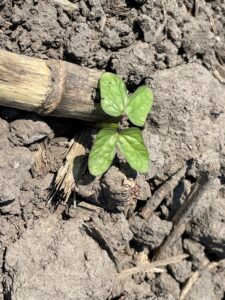 To Spray or Not to Spray? That is the question asked a lot this week. The best
To Spray or Not to Spray? That is the question asked a lot this week. The best
answer is – it depends. Here are some key things to consider:
1. What weed species are present in the field? Some weed species are more
competitive than others. The decision should be made field by field. I’d be more
concerned about waterhemp than velvetleaf.
2. What is the density of the species? Are the weeds here and there or are they
dense enough to further stress out the crop? Maybe the headlands need sprayed
sooner than the rest of the field. This is an option – really.
3. What growth stage is the crop in? If the crop is V2–V3 you have more time to
make a decision. If the crop is pushing V6–V7 (corn) or R1 (soybeans) you will need
to decide sooner on whether to stay with the same program and apply or change
herbicides to widen your window for application.
4. Is the crop showing stress? Spraying in the heat of the day with oily products
can further harm your crop. Are there cooler temperatures in the next few days
where an application would cause less potential harm? Patience may be needed.
5. What herbicides are you planning on using? Many herbicide labels advise not
to spray onto crops showing stress due to potential crop injury. READ THE LABEL.
6. Should you apply residual herbicides in dry weather? Refer back to 3, 4, and 5,
then ponder a few more questions. Has the residual you have already applied
been worked in with rain or light tillage? How soon will your crop canopy? What is
the chance of rain in the next 7–10 days? (Magic 8 Ball please tell us!)
The question to spray or not to spray is not an easy one. Make the decision field
by field. Leaving your windows down and doing a rain dance might be helpful,
too.


 and then
and then